Fear and self-loathing at Cirque du Soleil
When Review was invited to run away to Cirque du Soleil they jumped at the opportunity ... only to realise a wannabe acrobat was a mere office clown.
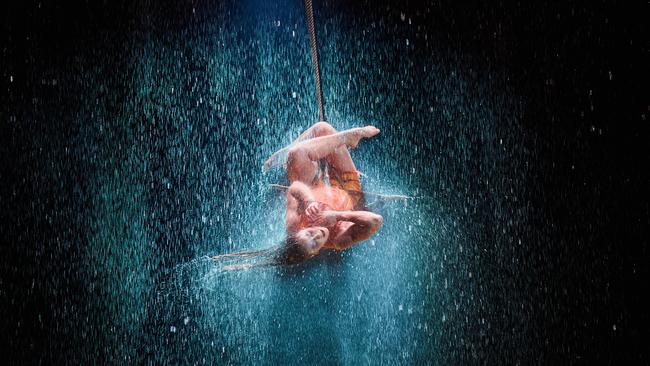
It’s humbling to face your corporeal shortcomings at what is meant to be the prime of your life. But there’s no denying it. Staring through a sterling silver acrobatic hoop under the big top of Cirque du Soleil and contemplating a circus trick for which I am grossly unqualified, the truth has become painfully apparent: I’m a mere office clown standing in front of an acrobat, asking them to teach me.
What the hell am I doing here?
On the training mats laid out before me are some of the world’s greatest performers. They hail from 26 countries; their expertise spans numerous circus-based artforms. The Cirque team has welcomed Review on this warm Sydney December morning to its rarefied fold to witness what exactly it might be like to run away to the circus. But if anyone were under the illusion that circus, in the hands of arguably the greatest troupe on the planet, is anything but a serious business, they’d be sorely mistaken.
The performers chat warmly, and stretch in tandem. Their bodies flex and bend in ways nature surely never intended but their limbs surrender to their will. Even their most casual warm-up routines appear expertly choreographed. In a clear indication this is no ordinary workplace, a newborn baby begins fussing next to its parents. Circus, it seems, remains a family business.
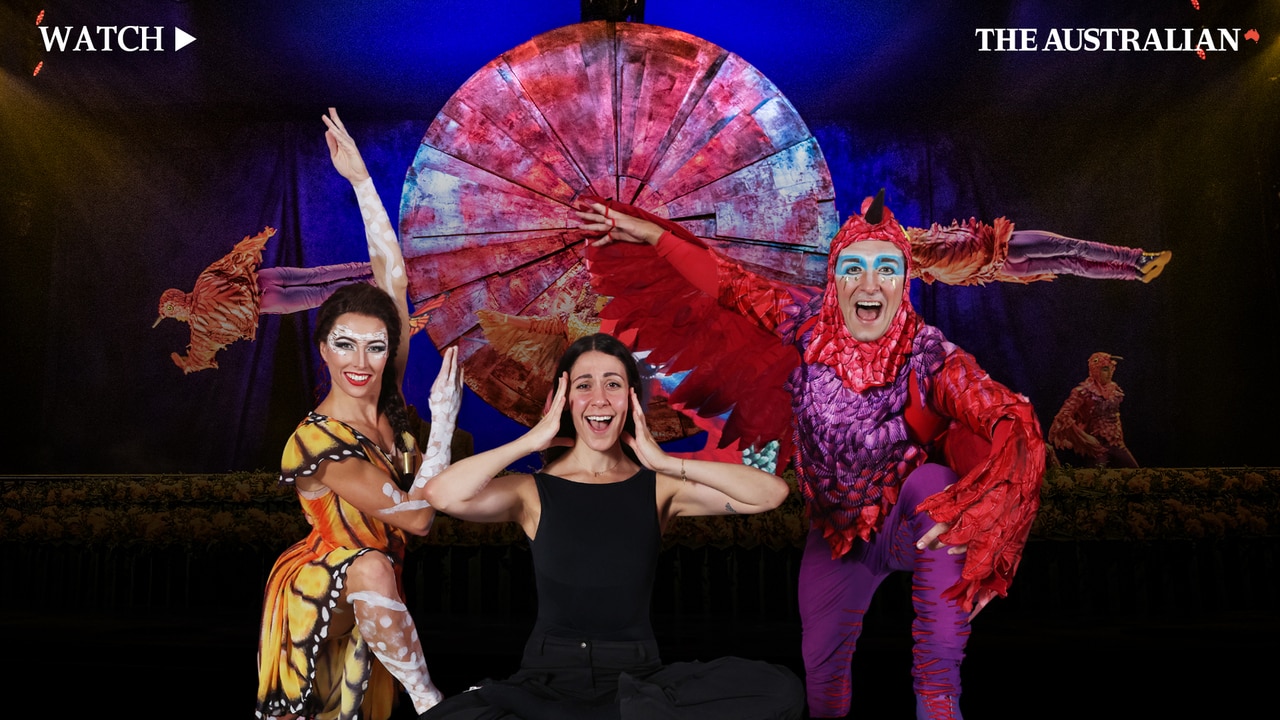
Flanking Review on the stretching floor are the Australian delegates of the long-running group’s Luzia show. Hoop artists Helena Merten, 29 and Nelson Smyles, 28 beam as they give Review the rundown on the day’s events. But first, some important background: the pair are known for leaping metres into the air from a standstill and executing impossible flips and spins before landing perfectly, all smiles and postural grace, on a moving treadmill.
Before I have a chance to protest that that might be out of my comfort zone, the pair has some reassuring news.
The trick Review will be attempting to execute – leaping through a series of standard size hula hoops stacked on top of one another and landing into a single somersault – is “fail safe”.
Fail safe, eh? We shall see about that.
The hoops, no more than a metre in radius, are held together with magnets, their metal bodies cold and terrifying.
A deep breath and a few false attempts at a stifled leap later, I send my body through the lowest circle, tightening my core and pointing my toes. I tuck my head into my chest, and roll out of the manoeuvre. To my astonishment, I have made it through this most peculiar entertainment torture contraption unscathed. Now, for the next level – the second tier suspended a metre and a half off the ground.
This is Cirque du Soleil’s 40th year of operation. Luzia, an ode to Mexico and the company’s 38th production since 1984, is showing in Sydney.
The troupe was founded in Quebec in the early ’80s by entrepreneurs Guy Laliberte and Gilles Ste-Croix. Laliberte had been inspired to enter the circus arts by the biography of legendary travelling showman PT Barnaum, and spent many years hitchhiking around North America with performance troupe Les Echassiers, which included acrobats, fire-breathers and jugglers. In 1984, Canada celebrated its 450th anniversary, and Laliberte had an idea: a province-wide tour charting the history of the nation. This was a circus with no animals.
It would tell the story of people, with people. As a new dawn broke in the performance world, the circus was given an apt name: Cirque du Soleil. “The sun symbolises youth, energy, and strength,” said Laliberte at the time.
From its humble beginnings, the troupe is now a global phenomenon. The company estimates more than 180 million people have seen its shows since 1984.
Regularly selling out shows around the globe, its annual revenue reportedly is close to $1bn.
Backstage, there is a flurry of movement. Lighting operators and security staff bustle past lycra-clad acrobats and performers in preparation for tonight’s performance of Luzia.
The routine of rehearsals is a rigorous one, says Merten.Performers rise late in the morning, only to practise death-defying acts until the late afternoon.
Alongside her cohort of hoop artists, the group completes two exercise blocks that conclude an hour before curtain up, rigorously contorting their bodies to make the performance the “easy” part of their day.
In one corner, a juggler throws a half-dozen cylindrical objects up to the roof of the tent beside a puppeteered horse; on the other, two men are swinging one of the dancers like a skipping rope before throwing the woman across the room into the arms of the resident strongman.
An alligator head – a focal costume of the show – appears above the antics like some absurd religious icon. There are, in line with the founding tenets of the troupe, no animals in this circus. And who needs them with superhumans such as these?
During rehearsal, Merten shimmies up a pole in seconds, instructing another to throw a camera to her so she might record the rehearsal and refer back to points of improvement.
“Our preparation routine varies a lot,” Merten says, moments after she emerges from a double backflip executed after leaping through a hoop suspended twice her height off the ground.
“Usually we spend two or three hours doing strength and conditioning training, on top of rehearsing, before each performance – except for the weekends.”
Smyles laughs and adds: “We have three shows on Saturday, so I do factor in a good nap.”
Merten has been entranced by the spectacle of Cirque du Soleil since she was a child, she says.
“When I was a seven-year-old, I thought I could take on the world … I thought if I could do a backflip as my job and get paid for it one day, then I’d go for it.”
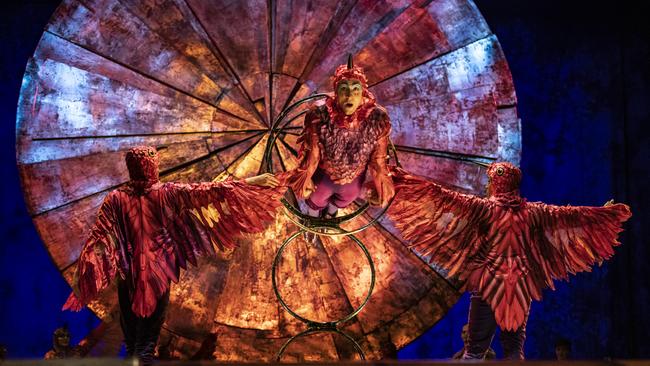
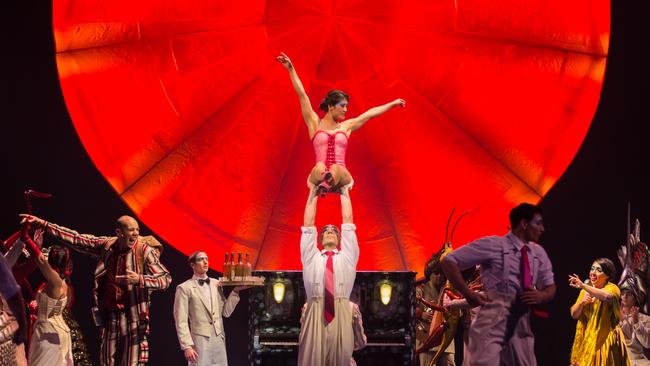
Smyles echoes the sentiment. As a former gymnast with a nomadic childhood, he turned to circus after years spent practising parkour – urban running – and a tenure at Melbourne’s National Institute of Circus Arts.
“I specialised in hoop diving and clowning there 40 hours a week,” the resident comedian of the group says, noting he woke one morning to an email asking for his availability to perform in Luzia.
“I thought it was spam initially but I replied anyway,” he says, laughing.
Performing is in his blood. His father – a ballroom dancer – competed at the Royal Albert Hall the year Cirque was founded.
“I was lucky enough decades later to perform on the same stage he danced on – it still gives me chills thinking about it, seeing him in the front row,” he says.
For Merten, she made her childhood dreams come true this year, performing with the troupe in Brisbane on the same stage that inspired her career 20 years prior.
“Just being on the other side of the audience and entertaining children who were my age when I first saw the show was very emotional,” she says.
Luzia stands unique in the 40-year canon of Cirque du Soleil performances for its major incorporation of water. And there is lots of water. Six-thousand litres, to be precise, all of which is recaptured and recycled for the next show. Simulated rain falls from the big top roof on to the stage, as trapeze acts whirl about in the deluge below.
Aerialists defy gravity as they perform in the centre of what becomes an on-stage sinkhole, created by a backstage cast of technicians, during the two-hour performance.
Ethan Westland, the Tasmanian-born assistant head of aquatics, admits to the occasional bout of butterflies. “I bite my nails through most of the show,” he says. “You feel on edge a bit.”
The former plumber and gas fitter stumbled on a gig with the travelling group following a spontaneous move to Canada. Having worked with the troupe for three years, he negotiates the logistics of 40-foot containers holding the water, hoses connected to fill the mid-stage pool and the show-stopping “rain curtain” that is the centrepiece of the act.
“Circus acts and water don’t usually go hand in hand,” he says. He points to the stage and to tiny holes – invisible to the naked eye – smattered throughout the grip-reinforced material. There are 94,000 of them, all designed to drain and recycle the fluids.
Westland says the troupe is always prepared to pivot should things go awry mid-performance. “I think everyone on this show is really good at reacting to things not going the way they need to go, because that happens daily – there’s too many variables here,” he says.
“If something were to go wrong, quite often the audience doesn’t even know and we fix it before it even becomes an issue.”
At the mention of things going wrong, I feel the knot tighten in my stomach. Why did I agree to do this?
Luzia has introduced a new form of hoop diving, wherein acrobats leap through suspended circles. In what we are told is a world first, Luzia’s performers have to negotiate a moving treadmill set to speeds Review has never dared run at the gym.
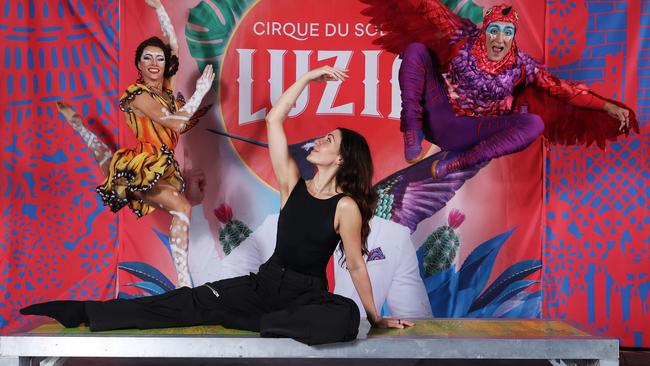
The precisely calculated dives of the rehearsing crew appear effortless. Some flip prior to entry; others after. Some, somehow, rotate halfway through hoop itself, landing perfectly into a jog on the moving treadmill, as they encourage the next member of the troupe.
We are warned not to stand directly in front of the performers in case they fly off into the front row of the crowd. With nothing but a plush mattress occasionally wheeled out for difficult tricks and a spotter, a fellow acrobat waiting to catch them, the team spend their days executing the ultimate trust fall.
“We all know that we want the best for each other out there, and you know, you can feel the support,” Merten explains. “You know, if you’re having an off day, they’re going to go and help you 100 per cent.”
Mertens’s castmate – and former classmate; the pair discovered recently they both attended A.B. Paterson College on the Gold Coast – says the extent of familiarity among the team breeds the kind of trust one might find in a family.
“We spend all of our time together at work, and, you know, we love hanging out outside of work, so it happens so naturally. I trust her as much as she trusts me, we’re just great friends above everything,” Smyles shares.
The arts and snobbery are often guilty of walking hand in hand, and as a form plagued with connotations of freak shows and clowns, circus is no exception.
The circus, the history of which stretches back to 18th century England, was for two centuries the entertainment du jour. The introduction of television in the 20th century saw a marked decline in live performances. Covid helped accelerate that process.
The “Greatest Show on Earth”, otherwise known as the Ringling Brothers’ 146-year long show, halted production four years, as seats emptied over criticism involving animal acts.
The nation’s biggest troupe, Circus Oz, ended its 44-year run in 2021.
However, in February the following year the company issued a statement noting “reports of our death have been greatly exaggerated”, premiering once again in 2023 as part of the Melbourne International Comedy Festival and continuing it’s run of performances.
The outlier in this country has been the internationally lauded Circa, the Brisbane-based group arguably better known overseas than it is in Australia. Artistic director and CEO Yaron Lifschitz, in fact, this week received the prestigious International Society for the Performing Arts 2025 Distinguished Artist Award.
So what is the key to keeping circus alive and relevant in the modern world?
Smyles says the key, as it always has been, is playing to the audience.
“Other artforms do require you to respect that craft a bit too much – but with the live entertainment, we’re reliant on our audience, and encouraging them to be who they want to be while reflecting the same energy,” he says. “It’s a very, very special part of the circus industry.”
Adds Merten: “It is not a very judgmental space – that’s the best thing to watch too, someone just being their honest self on a stage in a space where you can do the same.”
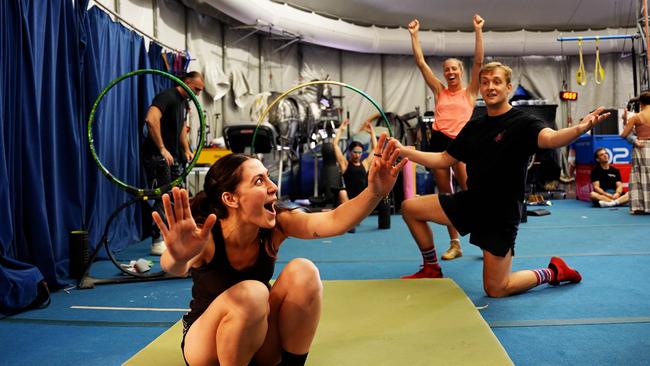
It’s a great comfort to hear from the pair as they prepare me to embark on an “intermediate” act, jumping through the second rung on the hoop device.
Horrified it will require me to somersault for a split second, with my chin tucked deep into my chest, the Russian delegation of the troupe surrounds the area in anticipation.
There are encouraging yells, applause and kind rebukes that what I’m attempting is in no way difficult by their metric of performance.
Still, I’m nervous. Like a small dog in the Westminster Kennel Club, I huff, indulge in a few false starts, and finally leap, feet dangling awkwardly behind me. My heart skips a beat as I feel my ankles clip the metallic hoop, and before I know it, I have kicked the prop across the room on my way to crashing gracelessly into the mat below.
The pair collapses in laughter beside me, and the three of us exchange high-fives. It’s a poor attempt, but I take solace in having achieved, with aplomb, the primary objective at the core of Cirque du Soleil: to provide maximum entertainment.
Cirque du Soleil’s Luzia plays at the Entertainment Quarter in Sydney until January 12.


To join the conversation, please log in. Don't have an account? Register
Join the conversation, you are commenting as Logout